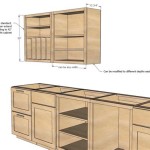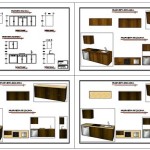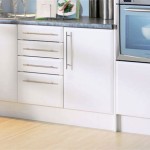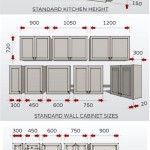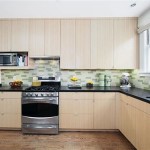Elevating Kitchen Design: The Impact of Crown Molding on Cabinets
Kitchen cabinets serve as the functional backbone of any kitchen design, providing essential storage space and contributing significantly to the overall aesthetic. While the cabinet doors, hardware, and countertop materials often receive the most attention, a crucial element that ties everything together and elevates the look is the addition of crown molding. Crown molding, applied to the top of kitchen cabinets, introduces a sense of formality, sophistication, and architectural detail, transforming ordinary storage solutions into statement pieces. This article will explore the various aspects of crown molding in kitchen cabinet design, covering its benefits, styles, installation considerations, and impact on overall kitchen aesthetics.
Crown molding is a decorative trim designed to bridge the gap between the top of the cabinets and the ceiling. Its primary function is to create a seamless transition, concealing any imperfections or gaps and providing a finished, polished look. However, its impact extends far beyond mere functionality. Crown molding adds visual height to the room, making the kitchen feel more spacious and grand. It also allows homeowners to personalize their kitchen design, choosing from a wide array of styles, materials, and finishes to complement their existing decor. Choosing the appropriate crown molding requires careful consideration of the kitchen's architectural style, the cabinet design, and the desired overall aesthetic.
Enhanced Aesthetic Appeal and Visual Impact
The most immediate benefit of adding crown molding to kitchen cabinets is the enhanced aesthetic appeal. Crown molding elevates the entire kitchen design, making it appear more refined and upscale. It acts as a visual frame, drawing the eye upward and highlighting the cabinets as a focal point within the room. The clean lines and defined edges of the molding add a sense of order and structure, contributing to a more cohesive and harmonious overall design. Without crown molding, cabinets can sometimes appear unfinished or lacking in visual interest. The addition of this decorative element creates a more complete and polished look, transforming standard cabinetry into a custom, high-end feature.
Furthermore, crown molding can be used to create different design styles. A simple, minimalist crown molding can complement a modern kitchen, while a more ornate and detailed molding can enhance a traditional or Victorian-style kitchen. The choice of molding profile, material, and finish can significantly impact the overall aesthetic of the kitchen, allowing homeowners to tailor the design to their individual preferences. The ability to customize the look through crown molding makes it a versatile and valuable addition to any kitchen renovation or remodeling project.
The visual impact of crown molding is also influenced by its size and proportion relative to the cabinets and the overall room. A molding that is too small can appear insignificant and fail to make a noticeable impact, while a molding that is too large can overwhelm the space and detract from the other design elements. Careful consideration should be given to the scale of the molding to ensure that it complements the surrounding features and contributes to a balanced and visually appealing design.
Variety of Styles, Materials, and Finishes
Crown molding is available in a wide range of styles, materials, and finishes, offering homeowners a multitude of options to customize their kitchen design. The style of the molding can range from simple and contemporary to ornate and traditional, allowing for seamless integration with various architectural styles and personal preferences. Common crown molding styles include: Colonial, Georgian, Victorian, Shaker, and modern minimalist designs. Each style features distinct characteristics, such as intricate carvings, geometric shapes, or clean, unadorned lines.
The materials used for crown molding also vary, with wood being the most common choice. Wood moldings can be made from a variety of species, including pine, oak, maple, and cherry, each offering its own unique grain pattern and color. Wood moldings can be stained, painted, or left natural, providing flexibility in matching the cabinets and other kitchen elements. Other materials used for crown molding include MDF (Medium-Density Fiberboard), which is a cost-effective and stable alternative to wood, and polyurethane, which is a lightweight and moisture-resistant option suitable for kitchens with high humidity levels. Each material has its advantages and disadvantages in terms of cost, durability, and ease of installation.
The finish of the crown molding is another important consideration. Painted moldings are a popular choice, as they allow homeowners to match the molding to the cabinet color or to create a contrasting accent. Stained moldings showcase the natural beauty of the wood grain and add warmth and richness to the kitchen decor. Other finishes, such as glazing, distressing, or metallic accents, can further enhance the visual appeal of the crown molding and create a unique and personalized look. The choice of finish should be carefully considered to ensure that it complements the overall kitchen design and reflects the homeowner's individual style.
Installation Considerations and Techniques
Proper installation is crucial to ensure that the crown molding looks its best and functions as intended. While some homeowners may choose to tackle the installation themselves, it is often recommended to hire a professional carpenter or contractor, particularly for more complex molding profiles or intricate designs. A skilled installer will have the necessary tools and experience to ensure that the molding is cut accurately, securely fastened, and properly aligned.
One of the key challenges in installing crown molding is achieving accurate cuts at corners and angles. Miter saws are essential for creating precise miter cuts, which are used to join two pieces of molding together at an angle. Coping saws can also be used to create coped joints, which are often preferred for inside corners as they allow for a more seamless and forgiving fit. Careful measuring and marking are essential to ensure that the cuts are accurate and that the molding fits snugly against the cabinets and the ceiling.
Proper fastening is also critical to ensure that the crown molding remains securely in place over time. Construction adhesive is often used to bond the molding to the cabinets and the ceiling, providing a strong and durable connection. Finish nails or screws can also be used to provide additional support and to prevent the molding from shifting or pulling away from the surface. It is important to use the correct size and type of fasteners to avoid damaging the molding or the cabinets.
In addition to the technical aspects of installation, there are also aesthetic considerations to keep in mind. The crown molding should be installed in a way that is visually appealing and that complements the overall kitchen design. Careful attention should be paid to the alignment of the molding, the spacing between pieces, and the overall symmetry of the installation. A well-installed crown molding will enhance the beauty and value of the kitchen, while a poorly installed molding can detract from the overall aesthetic.
Furthermore, preparation is key for successful crown molding installation. This includes ensuring the cabinet tops are level and properly prepared to accept the molding. Any gaps or imperfections should be addressed before the molding is installed. Using shims or fillers can help create a smooth and even surface, ensuring a professional and seamless finish. Also, proper safety precautions should be taken during the installation process, including wearing safety glasses and gloves to protect against potential hazards. Maintaining a clean and organized work area can also help to prevent accidents and ensure a smooth and efficient installation.
The addition of lighting can also enhance the effect of crown molding. Installing LED strip lights along the top of the cabinets, behind the crown molding, can create a soft, ambient glow that adds a touch of elegance and sophistication to the kitchen. This type of lighting, known as uplighting, highlights the architectural details of the molding and creates a warm and inviting atmosphere. The lighting can be controlled with dimmers, allowing homeowners to adjust the brightness and create different moods. The integration of lighting with crown molding is a simple yet effective way to elevate the overall aesthetic of the kitchen.
In conclusion, crown molding is a transformative element in kitchen design. Its ability to enhance aesthetics, offer diverse styling options, and create a refined, finished look makes it a valuable addition to any kitchen renovation or build. Prioritizing careful planning, quality materials, and professional installation ensures that the crown molding not only meets functional requirements but also becomes a focal point that elevates the entire kitchen space.

3 Ways To Enhance Your Kitchen With Crown Molding

3 Ways To Enhance Your Kitchen With Crown Molding

Crown Moulding The Recently Rediscovered Kitchen Solution

Adding Crown Molding To Kitchen Cabinets Young House Love

Diy Kitchen Cabinet Upgrade With Paint And Crown Molding

A Guide To Crown Molding For Kitchen Cabinets Mimosa Bath

Decorative Molding Timberlake Cabinetry

11 Kitchen Cabinet Crown Molding Ideas For Your

11 Kitchen Cabinet Crown Molding Ideas For Your

Cabinet Crown Molding Rogue Engineer
Related Posts

